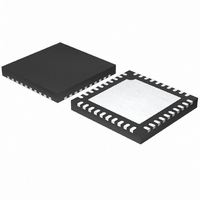MAX1566ETL+ Maxim Integrated Products, MAX1566ETL+ Datasheet - Page 29

MAX1566ETL+
Manufacturer Part Number
MAX1566ETL+
Description
IC DGTL CAM PWR-SUP 6CH 40TQFN
Manufacturer
Maxim Integrated Products
Datasheet
1.MAX1567ETLT.pdf
(35 pages)
Specifications of MAX1566ETL+
Applications
Controller, Digital Camera
Voltage - Input
0.7 ~ 5.5 V
Number Of Outputs
7
Voltage - Output
1.25 ~ 5 V
Operating Temperature
-40°C ~ 85°C
Mounting Type
Surface Mount
Package / Case
40-TQFN Exposed Pad
Lead Free Status / RoHS Status
Lead free / RoHS Compliant
For the example:
Choose 47µF for C
stantially different from the calculated value, insert the
available C
recalculate R
higher R
consequently less transient droop.
If the output filter capacitor has significant ESR, a zero
occurs at the following:
If Z
with ceramic output capacitors. If Z
it should be cancelled with a pole set by capacitor C
connected from CC to GND:
If C
This section describes component selection for the
step-down converter, and for the main converter if used
in step-down mode (SUSD = GND).
The external components required for the step-down
are an inductor, input and output filter capacitors, and
compensation RC network.
The MAX1566/MAX1567 step-down converter provides
best efficiency with continuous inductor current. A rea-
sonable inductor value (L
the following:
This sets the peak-to-peak inductor current at 1/2 the
DC inductor current. D is the duty cycle:
Given L
I
Inductance values smaller than L
reduce inductor size; however, if much smaller values are
used, inductor current rises, and a larger output capaci-
tance may be required to suppress output ripple. Larger
values than L
current, but typically with larger inductor size.
The relevant characteristics for step-down compensa-
tion are as follows:
• Transconductance (from FB to C
OUT
ESR
P
. The absolute-peak inductor current is 1.25 I
is calculated to be <10pF, it can be omitted.
L
> f
IDEAL
IDEAL
C
C
, which provides higher transient gain and
C
OUT
, it can be ignored, as is typically the case
OUT
Z
Step-Down Component Selection
C
, the peak-to-peak inductor current is 0.5
IDEAL
ESR
. Higher substituted C
= [2(V
C
= 68kΩ x 6.8nF / 10Ω = 46µF
value into the above equation and
P
= 1 / (2π x C
______________________________________________________________________________________
= C
can be used to obtain higher output
OUT
D = V
IN
) x D(1 - D)] / I
OUT
. If the available C
OUT
IDEAL
Step-Down Compensation
x R
Six-Channel, High-Efficiency, Digital
OUT
/ V
ESR
) can be derived from
IN
IDEAL
Step-Down Inductor
C
x R
/ R
ESR
), gm
OUT
OUT
C
ESR
can be used to
is less than f
values allow a
EA
x f
)
OUT
OSC
(135µS)
is sub-
OUT
C
P
,
.
Camera Power Supplies
• Step-down slope-compensation pole, P
• Current-sense amplifier transresistance, R
• Feedback-regulation voltage, V
• Step-down output voltage, V
• Output-load equivalent resistance, R
The key steps for step-down compensation are
as follows:
1) Set the compensation RC to zero to cancel the
2) Set the loop crossover below the lower of 1/5 the
If we assume V
350mA, then R
If we select f
P
and calculate C
Choose 6.8nF.
Now select R
met. As an example, if 4% transient droop is allowed,
the input to the error amplifier moves 0.04 x 1.25V, or
50mV. The error-amp output drives 50mV x 135µS, or
6.75µA across R
current-sense transresistance is 0.6V/A, the value of R
that allows the required load-step swing is as follows:
In a step-down DC-to-DC converter, if L
output current relates to inductor current by the following:
So for a 250mA output load step with V
V
Choose 27kΩ.
Note that the inductor does somewhat limit the response
in this case since it ramps at (V
(2.5 - 1.8) / 5.6µH = 125mA/µs.
The output filter capacitor is then chosen so the C
R
SLOPE
OUT
LOAD
C
(πL)
(0.6V/A)
V
R
slope compensation pole or 1/5 the switching
frequency.
C
OUT
LOAD
= (V
= (1.25 / 1.8)(5.14 / 0.6) x [135µS / (6.28 x 24kHz)]
= 6.4nF
= 1.8V:
R
pole cancels the R
C
/ I
= V
FB
= (1.25 x 0.6 x 0.25) / 6.75µA = 27.8kΩ
LOAD
C
OUT
IN
OSC
/ V
C
LOAD
/ (πL) = 142kHz, so choose f
R
C
OUT
C
C
OUT
IN
pole.
so transient-droop requirements are
C
:
= 500kHz and L = 5.6µH.
I
= 0.6 I
IND(PK)
)(R
to provide transient gain. Since the
= 2.5V, V
= 5.14Ω.
x R
LOAD
LOAD
IND(PK)
C
= 1.25 I
/ R
C
OUT
C
= R
CS
SD
zero:
/ 6.75µA
IN
, in V
)(gm / 2π x f
FB
OUT
C
= 1.8V, and I
- V
x C
(1.25V)
OUT
C
IDEAL
IN
LOAD
SLOPE
) / 5.6µH, or
= 2.5V and
C
C
)
= 24kHz
, in Ω =
is used,
= V
OUT
OUT
IN
CS
29
=
C
/











